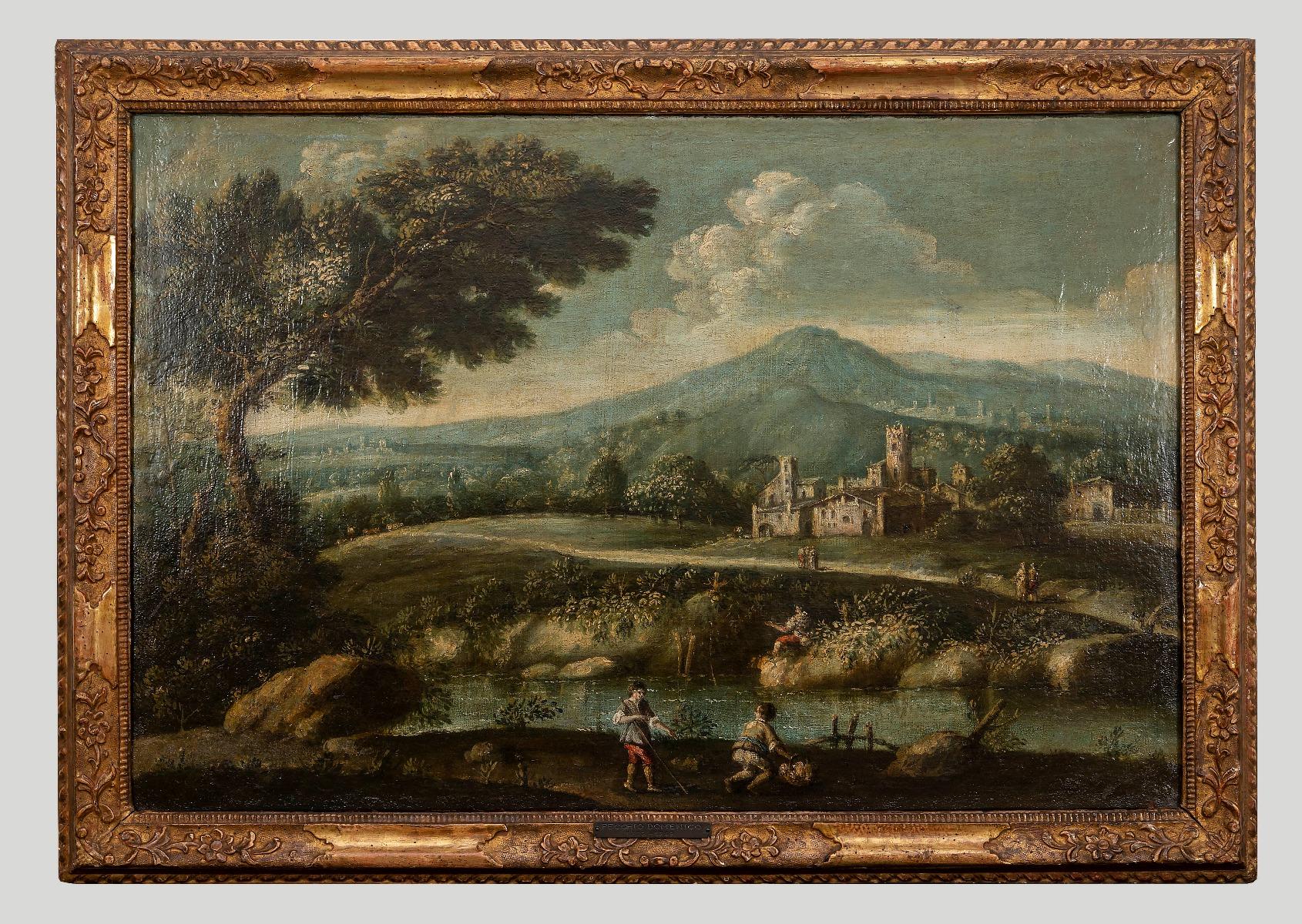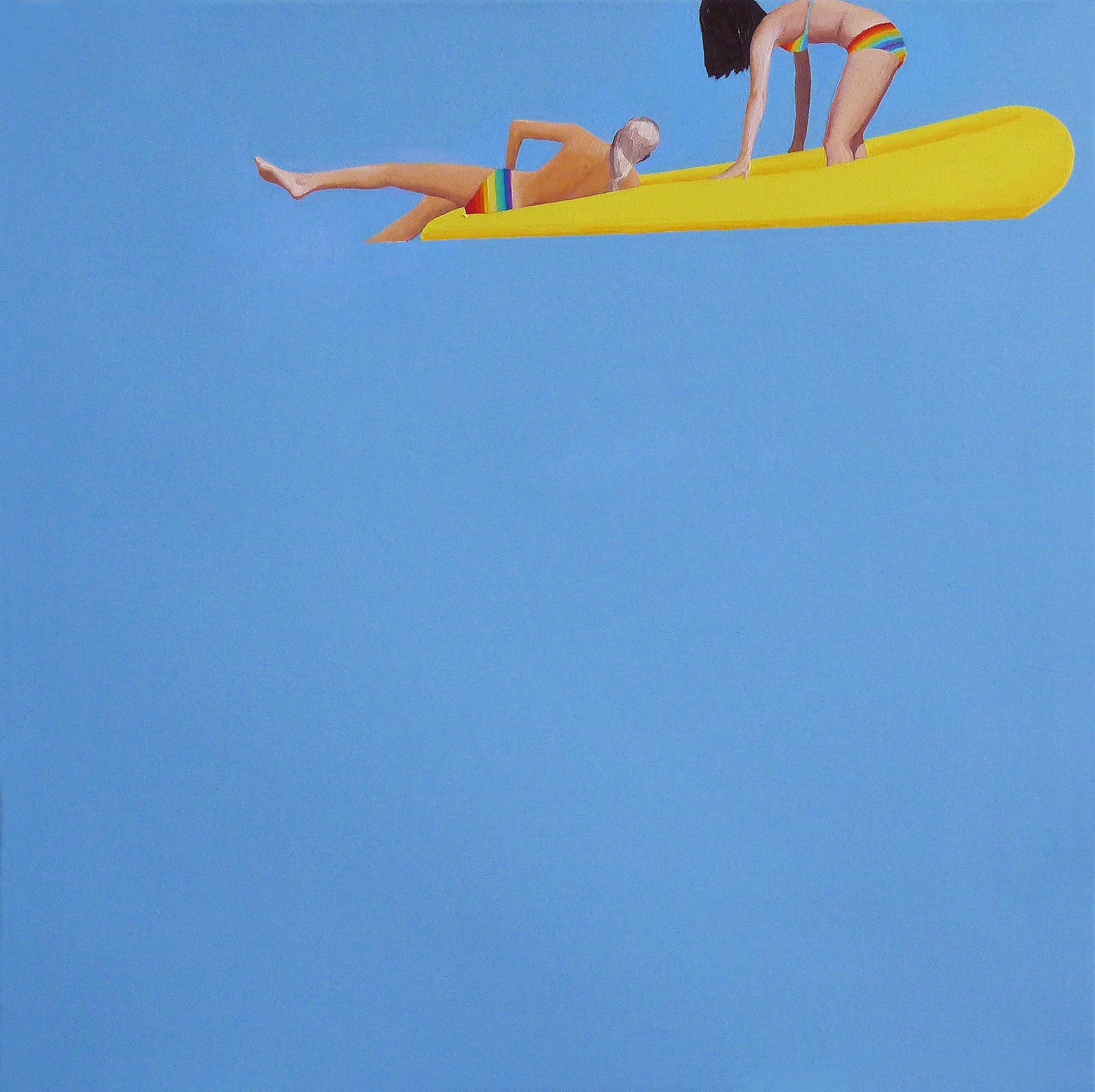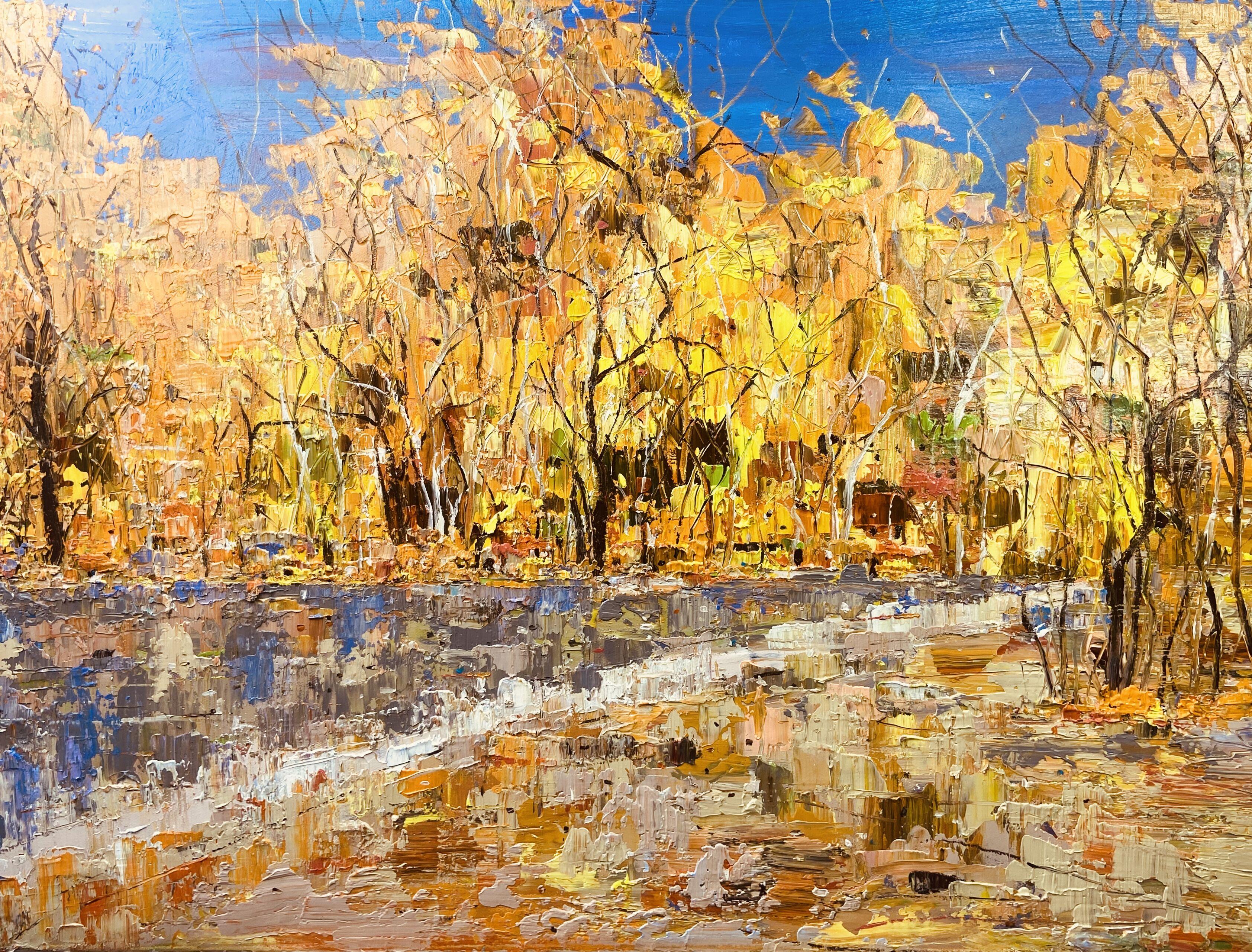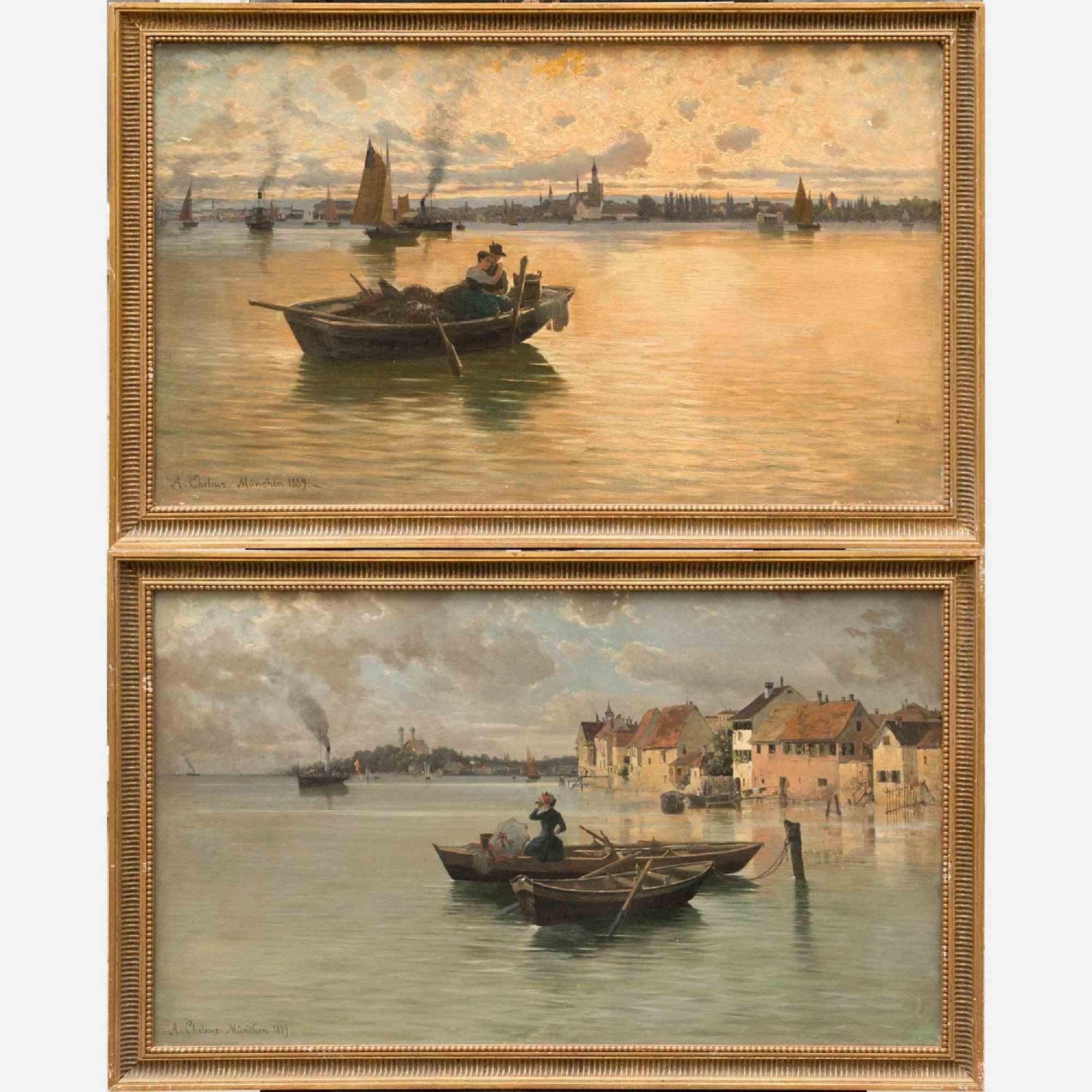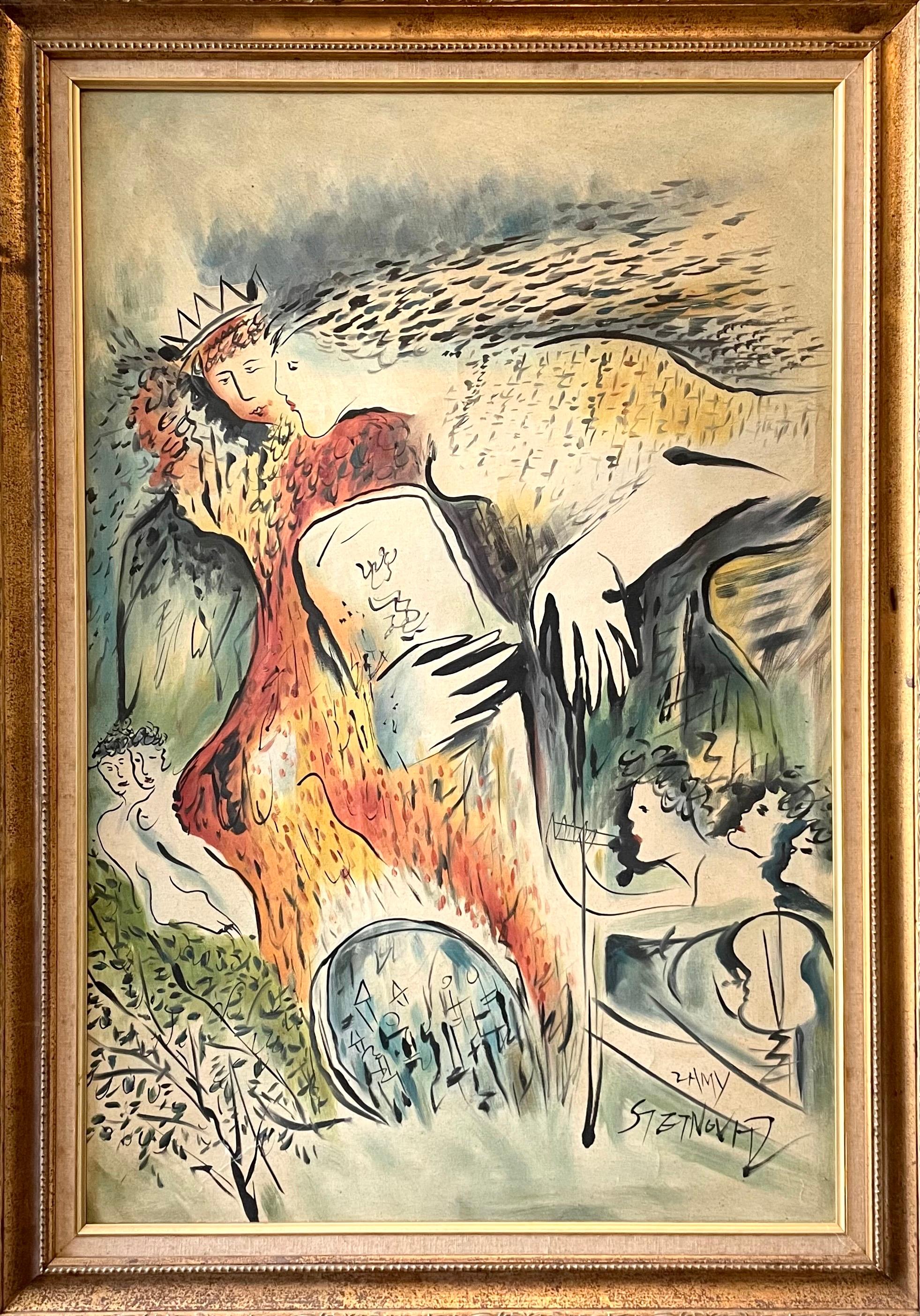Items Similar to Judaica Polish Oil Painting Hasidic Jewish Prayers, Israeli Soldiers Jerusalem
Want more images or videos?
Request additional images or videos from the seller
1 of 14
Simon Natan KarczmarJudaica Polish Oil Painting Hasidic Jewish Prayers, Israeli Soldiers Jerusalemc.1950s
c.1950s
About the Item
Israeli Tzahal, IDF Soldiers and Chassidic men praying and dancing at the Kotel, Western Wall in jerusalem israel. Fine oil painting.
24 x 18 canvas, 32.5 x 27.5 inches with frame.
Simon Natan Karczmar (born November 1, 1903 in Warsaw , died 1982 in Safed ) - Polish and Israeli painter.
He was born as Szmaja Karczmar, he studied at the Warsaw School of Fine Arts. He earned a living by importing fur from Russia, which he sold to a cousin who was a furrier. With time, he gained a lot of experience and became an excellent sorter. In 1929 he left for Paris , where he continued his studies in painting. In 1931 he met Nechuma ( Nadia) from Poland, whom he married. Because it was difficult to support the family out of the sale of paintings, he returned to the sorter's work, and his wife started working at perfume Les Lilas in one of the suburbs of Paris. During the Second World War, the persecution of Jews also affected France, so in 1941 he and his family left for Nice. Shortly thereafter the father of Nechuma was denounced to the Gestapo and murdered by a German militiaman. Nechuma was arrested and transported to Auschwitz , Simon joined the partisans at that time. After the war, Nechuma returned to France and reopened perfume. In 1951, the Karczmarów family decided to emigrate to Israel, Simon and his brother-in-law ran a metallurgical plant, but because of losses they had to shut it down. In 1955 they were invited by a friend to Canada, they lived in Montreal where Simon worked again as a fur sorter. In 1959 he got allergies and had to abandon his previous job, he was depressed due to bad financial situation. Simon Karczmar began to paint in a naive way memories of childhood, thanks to which he managed to give them an authentic character and show those places and times through the eyes of a child. His work received positive reviews, he had an individual exhibition at an art gallery in Montreal. In 1960, together with his wife, he left Canada and left for Mexico, where Simon co-organized the Museum of Film Art. At the Centro Deportivo there was a second individual exhibition of his works, and after that he was invited to exhibit paintings in two other galleries. He also received a job offer in the United States and Canada. In 1962 he went to Israel again, where he settled in the art colony in Safed and studied new painting techniques. Although he left France for Israel most of his work evokes his experiences in Eastern Europe. He traveled many times to New York , where he eagerly spent the winter. He died in Safed when he was 79 years old.
The Portrait in Palestine, The Bezalel National Museum, Jerusalem
13 February, 1934 - 25 March, 1934
Artists:
Boris Schatz, Hermann Struck, Jakob Steinhardt, Tadeusz Rychter, Simon Karczmar, Moshe Castel, Avigdor Stematsky, Shmuel Charuvi, Meir Gur Arie, Joseph Budko, Jacob Eisenberg and more.
Simon Karczmar's paintings depict the world of his childhood, depict the everyday life of Polish Jews, their culture, customs, celebrations and holidays. You can see the figures of musicians, traders, buildings of Jewish districts and interiors of their houses. Thanks to the naive technique used, viewers look at the world of the painter's childhood through his eyes. The series of paintings entitled Shtetl depicts paintings remembered by the artist from his grandfather's stay in a small Jewish town near Vilnius In this series of images known collectively as Shtetl, (popularized by Sholem Aleichem, Marc Chagall and Chaim Goldberg) Karczmar draws inspiration from his childhood memories of the vacations he spent at his grandfather's house in Lithuania. The word shtetl is Yiddish for little town and refers to the villages with significant Jewish populations that could once be found throughout Eastern Europe.
The nostalgia of Karczmar's renderings contrasts with the darker views of life for Jews revealed in the photographs by Roman Vishniac and drawings of Ephraim Moshe Lilien. While the photographs in The Vanished World seem to emphasize the deprivation experienced by Jews in the years leading up to World War II, Karczmar depicts similar scenes yet focuses on the sense of community and tradition. His works weep with a classic Eastern European naivety shrouded in dark sad colors
- Creator:
- Creation Year:c.1950s
- Dimensions:Height: 32.5 in (82.55 cm)Width: 27.5 in (69.85 cm)
- Medium:
- Movement & Style:
- Period:
- Condition:Good. frame has wear. please see photos. size includes frame.
- Gallery Location:Surfside, FL
- Reference Number:1stDibs: LU3826071702
About the Seller
4.9
Platinum Seller
These expertly vetted sellers are 1stDibs' most experienced sellers and are rated highest by our customers.
Established in 1995
1stDibs seller since 2014
1,539 sales on 1stDibs
Typical response time: 1 hour
- ShippingRetrieving quote...Ships From: Surfside, FL
- Return PolicyA return for this item may be initiated within 3 days of delivery.
More From This SellerView All
- King David, Jerusalem (after Marc Chagall) Oil Painting Israeli Judaica ArtBy Zammy SteynovitzLocated in Surfside, FLFramed 41.5 x 29.5 image 35.5 x 23.5 This large painting depicts a man and woman, Adam and Eve, interlocked and embracing one another. The woman holds an enticing apple as they are thrusted from the Garden of Eden. This is an original painting. Zamy Steynovitz was born in Liegnitz Poland, in 1951. He immigrated to Israel in 1957. The aspiration to be a painter stems from his childhood and before leaving Poland, he won the first prize in an art competition for children. Zamy was formally educated at the Art School in Tel-Aviv and at the Royal Academy of London. Upon completing his studies, Zamy earnestly pursued his career and establish his place in the art world by displaying his work in one man exhibits and arts fairs around the world. His art displays chromatic and thematic richness and his choice of subjects has been strongly influenced by Jewish tradition, his Eastern European Jewish heritage and folklore. Zamy’s popular themes include Paris cafes, still-life, flowers, circuses and landscapes. Circus with acrobats and Harlequin. In the early stages of his career, he was partial to rich pastels and light brush strokes. In the early 1980s, Zamy visited South America, where the new surroundings enhanced his work with local brightness and color. His art gained chromatic power and his palette became richer in tones as the textures became thicker and the background darker and more colorful. These changes coupled with his thematic persistence allowed him to develop into a sensitive and mature artist. Zamy expresses a universal humanistic vision in his creations: man’s connection to his heritage and physical surroundings, two imperative aspects of our lives that should be heralded during these estranged technological times. As a result of his devotion to world peace, Zamy is known in the circles of the Nobel Institute for Peace in Norway. He is acquainted with many Nobel Prize winners including Anwar Sadat, Menachem Begin, the Dalai Lama, Itzhak Rabin, Shimon Peres, Elie Wiesel, Desmond Tutu and Oscar Arias, the ex-President of Costa Rica, along with many other politicians and artists. Zamy tragically passed away in September 2000. Exhibitions One Man Show 1970 - Museum - Ramat - Gan 1973 - Brussels - Gallery L'Angle Aigu 1974 - London - International Gallery 1974 - Paris - Grand Palais Gallery 1975 - Milan - Brera Gallery 1976 - N.Y. Valentino Gallery - N.Y. Hilton 1977 - N.Y. Valentino Gallery - N.Y. Hilton 1978 - Basel - Actual Gallery 1978 - Geneve - Bohren Gallery 1978 - Oslo - Nobel Peace Prize Exhibit 1979 - London - Hamilton Gallery 1979 - N.Y. - Art Israel Kalt - Waldinger Gallery 1979 - N.Y. - Canty Art Gallery 1979 - Amsterdam - Schipper Gallery 1979 - Washington - International Art Fair 1980 - Cleveland -Jewish Museum 1980 - Tel-Aviv - Habima National Art Fair 1981 - Abraham - Goodman House N.Y. 1981 - San Lucas Galley - Bogota 1982 - Pedro Gerson Gallery - Mexico City 1983 - Simon Bolivar...Category
20th Century Modern Figurative Paintings
MaterialsCanvas, Oil
- Austrian Magic Realist Oil Painting Vibrant Village Landscape Scene Franz CoufalLocated in Surfside, FLFramed 24.5 x 28.5 image 19.5 x 23 inches. Franz Anton Coufal (Austrian, 1927 - 1999) Painter and sculptor known for figure painting, bronze sculpture, genre paintings and as a graphic artist. After completing an apprenticeship as a locksmith, Franz Anton Coufal attended the Graphic Education and Research Institute in Vienna from 1947 to 1949 as a student of André Roder and from 1949 to 1953 took lessons from Ignaz Schönbrunner. From 1953 to 1959 he finally studied with Fritz Wotruba at the Academy of Fine Arts (diploma and master school award 1959). Coufal then went on study trips to Germany and Italy and then settled in Vienna as a sculptor and graphic artist. His work bears the influence of Austrian Magic Realism and the artists Friedensreich Hundertwasser, Arik Erich Brauer and Ernst Fuchs. THis work also has Expressionist elements to it. He organized exhibitions in Vienna (from 1955), Paris (1962, 1970) and Brussels (1964) as well as in other Austrian cities. His most important works include the honorary grave for Leopold Figl in the central cemetery (1966). In 1979 he provided the design for the face of the silver 100 schilling coin "Festival and Congress House Bregenz", in 1980 he created the Lehár monument for the city park, and in 1987 he received the special prize in the "Danube Region Vienna" competition. A select list of his sculptures in public spaces "Standing youth" (19, Hameaustraße - Celtesgasse, urban residential complex; 1960) "Reclining youth" (22, Kagran [Meißnergasse - Maißauer Gasse - Anton-Sattler-Gasse]; artificial stone, 1962) "Flammender Turm" (16, Thaliastraße 159; marble) Cubist marble sculpture (11, Molitorgasse at 15) Drinking fountain (20, Adalbert-Stifter-Straße primary school; 1968) Figldenkmal (1, Minoritenplatz, 1973) Coufal created some of his later works for the "Harmonie" rest home for the blind in Unterdambach near Neulengbach (memorial for the 144 blind people who perished in concentration camps, unveiled in 2000; stone sculpture "Monument to Humanity" on the terrace; rose-thorn cross and tabernacle for the in-house Odilien- Chapel; bronze portrait sculpture by Robert Vogel in the entrance hall, unveiled July 3, 1994). Bibliography Rudolf Schmidt: Austrian artist lexicon. From the beginning to the present. Vienna: Tusch 1974-1980 Who's Who in the world. Volume 2: 1974-1975. New Providence, NJ: Marquis Who's Who 1974 Who's who in the world. Volume 3: 1976-1977. New Providence, NJ: Marquis Who's Who 1976 Who is Who in Austria with South Tyrol part (Hübner's "Blue Who is Who"). Zug: Who is who, Verlag für Personalenzyklopädien 12 1995 Otto Breicha: Franz Anton Coufal In: Franz Anton Coufal. Österreichische Staatsdruckerei, December 9-22, 1964. Vienna: Staatsdruckerei 1964 The press, July 30, 1963 Of the generation of Viennese artists Alois Mosbacher, Josef Mikl, Oswald Oberhuber, Christian Ludwig Attersee, Peter Sengl, Max Weiler, Franz Ringel, Gunter Brus, Hubert Schmalix, Wilhelm Kaufmann, Paul Flora, Oscar Larsen, Hans Staudacher, Siegfried Anzinger, Ernst Huber...Category
20th Century Modern Landscape Paintings
MaterialsOil, Canvas
- 1927 Oil Painting Eiffel Tower Paris American Modernist Wpa Artist Morris KantorBy Morris KantorLocated in Surfside, FLMorris Kantor New York (1896 - 1974) Paris from the Ile St. Louis, 1927 (view of Eiffel Tower) Oil painting on canvas Hand Signed lower left. Provenance: Hirshhorn Museum and Sculpture Garden, Smithsonian Institution ( bears label verso) Size: 20 3/4"H x 28 1/8"W (sight), 28.75 "H x 36"W (framed) Morris Kantor (Belarusian: Морыс Кантор) (1896-1974) was a Russian Empire-born American painter based in the New York City area. Born in Minsk on April 15, 1896, Kantor was brought to the United States in 1906 at age 10, in order to join his father who had previously relocated to the states. He made his home in West Nyack, New York for much of his life, and died there in 1974. He produced a prolific and diverse body of work, much of it in the form of paintings, which is distinguished by its stylistic variety over his long career. Perhaps his most widely recognized work is the iconic painting "Baseball At Night", which depicts an early night baseball game played under artificial electric light. Although he is best known for his paintings executed in a realistic manner, over the course of his life he also spent time working in styles such as Cubism and Futurism, and produced a number of abstract or non-figural works. A famous cubist, Futurist, painting of his "Orchestra" brought over 500,000$ at Christie's auction house in 2018 Kantor found employment in the Garment District upon his arrival in New York City, and was not able to begin formal art studies until 1916, when he began courses at the now-defunct Independent School of Art. He studied landscape painting with Homer Boss (1882-1956). In 1928, after returning to New York City from a year in Paris, Kantor developed a style in which he combined Realism with Fantasy, often taking the streets of New York as his subject matter. He did some moody Surrealist Nude paintings and fantasy scenes. In the 1940's he turned towards figural studies. Later in his career, Kantor himself was an instructor at the Cooper Union and also at the Art Students League of New York in the 1940s, and taught many pupils who later became famous artists in their own right, such as Knox Martin, Robert Rauschenberg, Sigmund Abeles and Susan Weil...Category
1920s American Modern Landscape Paintings
MaterialsCanvas, Oil
- Outside the Synagogue Russian Judaica Oil PaintingBy Emmanuel SnitkovskyLocated in Surfside, FLThis piece came from the collection of the Bezalel Art Gallery on the Lower East Side of New York City. Emmanuil Snitkovsky is an internationally known artist, sculpture and poet. ...Category
1980s Modern Landscape Paintings
MaterialsCanvas, Oil, Illustration Board
- 1930 Oil Painting Sea Side Sailboats American Modernist WPA Artist Morris KantorBy Morris KantorLocated in Surfside, FLMorris Kantor, American, 1896-1974 Seaside View, 1930 Hand signed M. Kantor and dated 1930 lower right Oil on canvas 22 1/4 x 19 1/4 inches 24 1/2 x 21 (frame) Morris Kantor (Belarusian: Морыс Кантор) (1896-1974) was a Russian Empire-born American painter based in the New York City area. This is a beautiful boat scene with a river or lake probably on Long Island. Born in Minsk on April 15, 1896, Kantor was brought to the United States in 1906 at age 10, in order to join his father who had previously relocated to the states. He made his home in West Nyack, New York for much of his life, and died there in 1974. He produced a prolific and diverse body of work, much of it in the form of paintings, which is distinguished by its stylistic variety over his long career. Perhaps his most widely recognized work is the iconic painting "Baseball At Night", which depicts an early night baseball game played under artificial electric light. Although he is best known for his paintings executed in a realistic manner, over the course of his life he also spent time working in styles such as Cubism and Futurism, (influenced by the Art Deco movement) and produced a number of abstract or non-figural works. A famous cubist, Futurist, painting of his "Orchestra" brought over 500,000$ at Christie's auction house in 2018. Kantor found employment in the Garment District upon his arrival in New York City, and was not able to begin formal art studies until 1916, when he began courses at the now-defunct Independent School of Art. He studied landscape painting with Homer Boss (1882-1956). In 1928, after returning to New York City from a year in Paris, Kantor developed a style in which he combined Realism with Fantasy, often taking the streets of New York as his subject matter. He did some moody Surrealist Nude paintings and fantasy scenes. In the 1940's he turned towards figural studies. Later in his career, Kantor himself was an instructor at the Cooper Union and also at the Art Students League of New York in the 1940s, and taught many pupils who later became famous artists in their own right, such as Knox Martin, Robert Rauschenberg, Sigmund Abeles and Susan Weil...Category
1930s American Modern Landscape Paintings
MaterialsCanvas, Oil
- Fantastic Village Scene Modern Irish Magic Realism Oil PaintingBy Philip CastleLocated in Surfside, FLPhilip Castle was an Irish Painter and husband to artist Barry Castle He is rarely exhibited. His detailed, meticulous work took a long time to complete...Category
20th Century Folk Art Landscape Paintings
MaterialsCanvas, Oil
You May Also Like
- Landscape with figures - Original Oil Paint On Canvas - 18th CenturyLocated in Roma, ITLandscape with figures is an original oil on canvas realized in the XVIII Century by a Venetian School Master. Original oil painting on Canvas. The painting represents a beautiful...Category
18th Century Modern Landscape Paintings
MaterialsOil, Canvas
- Rainbow - Minimalistic Figurative Oil Painting, Beach View, Realism, SeascapeBy Julita MalinowskaLocated in Salzburg, ATArtodyssey "Julita Malinowska's paintings belong to those, which once seen - are never forgotten. The open spaces, sometimes cool and bright, at other times heavily saturated with co...Category
2010s Modern Figurative Paintings
MaterialsCanvas, Oil
- Figurative landscape oil painting- VitalityLocated in Beijing, CNDai Xiangwen was born in Hunan in 1991 and graduated from the Academy of Fine Arts of Jianghan University, He is a member of China Artists Association, China Designers Association, a painter of Li Keran...Category
2010s Modern Figurative Paintings
MaterialsCanvas, Oil
- Pair of Romantic Bavarian Paintings by Karl Adolf Wilhelm Chelius - 1889Located in Roma, ITPair of romantic Bavarian paintings is an old master artwork realized in 1889 by the master Karl Adolf Wilhelm Chelius (1856-1923). Mixed colored oil panting on...Category
1880s Modern Landscape Paintings
MaterialsOil, Canvas
- Spring , Modernist Native American Ceremonial Scene and Cultural CommentaryLocated in Doylestown, PA"Spring" is a 25 x 30 inches, oil on canvas painting by American modernist and surrealist, female artist Peter Miller. The work is signed and titled on verso, and painted in a vibran...Category
1940s American Modern Landscape Paintings
MaterialsCanvas, Oil
- 1998 Vintage Swedish Framed Cityscape Oil Painting by Uno Vallman - City TourLocated in Bristol, GBCITY TOUR Size: 64.5 x 56 cm (including frame) Oil on Canvas A lively and energetic city street scene composition, executed in oil onto canvas and dated 1998 by Swedish artist Uno V...Category
1990s Modern Landscape Paintings
MaterialsOil, Canvas
